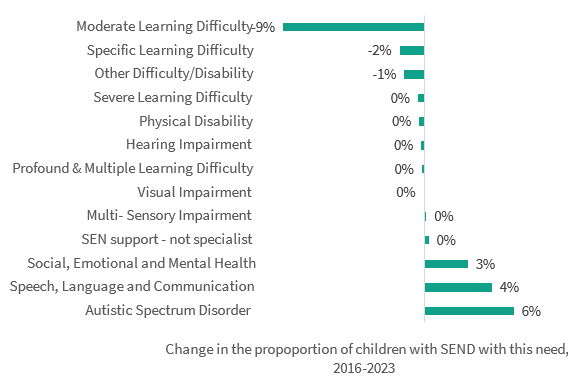Special Educational Needs and Disabilities
Pupils with special educational needs and disabilities (SEND) are some of the most educationally disadvantaged in the English state school system. Our previous research has found that four in ten children are identified as SEND at some point between the ages of 5 and 16.[1] In our analysis we distinguish between pupils who receive support in school (SEN support) and those with more complex needs set out in an education, health and care plan (EHCP), and we compare both groups to their peers with no identified needs.
SEN support is extra help given to children and young people in mainstream school or college specifically to help with their special educational needs. It is additional to (or different from) the support generally given to other children of the same age. Those children (and adult up to age 25) who need more support than is available through SEN support can apply to their local authority for an EHCP, which provides higher levels of support (and funding) than is available through SEN support.
In recent years there have been changes in the types of need identified for both children receiving SEN support and with an EHCP.[2] These changes are detailed in the boxout below.


SEN support
By the end of reception year, children receiving SEN support were over a year behind children with no identified SEN in 2023, highlighting that there are already sizeable gaps for pupils with additional needs on starting school. This gap is now at its highest level since our time-series began in 2013.
At the end of primary school, the gap between children receiving SEND support and those with no identified SEND was over a year and a half (17 month). Although this is still a worryingly large gap, it does represent a narrowing of 1.4 months since 2019 and it is now at its lowest level since the beginning of our series in 2011 (when it was 21 months).
The SEN support gap at the end of secondary was just over 22 months in 2023. Again, while this is still a large gap, our analysis shows that it has narrowed during both the pre- and post-pandemic periods, reducing by over six months since 2011 by over 2 months since 2019. It is plausible that these falls may be related to the changes we are seeing in types of SEND, though further research is required to confirm this.
Figure S2: Gaps for children in key stages 2 and 4 who received SEN support are significant though have been on a downward trend for over a decade, whilst the EYFS gap increased in 2023
In the 16-19 phase, we report gaps based on students’ SEND status recorded at the end of key stage 4.
As in key stage 2 and key stage 4, the SEND support gap in 16-19 education has been decreasing in recent years. In 2023, students with SEND support were 3.7 grades behind students with no identified SEND, but this was the lowest gap observed since our time series began in 2017.
Figure S3: Gaps for students in 16-19 education who received SEN support in key stage 4 are substantial, but this gap has been closing over the last 7 years
Education Health and Care Plans
Attainment gaps are wider still for pupils with more complex needs. For children in reception year with an EHCP, the gap in 2023 was 19.9 months. Over the decade to 2023, the gap has gradually widened by around 0.5 months to its largest on record.
Meanwhile the EHCP gap for pupils at the end of primary school was 27.4 months in 2023. Following a plateauing in the gap in the late 2010s, the gap is now at its lowest level since the beginning of our series in 2011, when it was 2.3 months larger, at 29.8 months.
By the end of secondary school, the EHCP gap was wider still, at almost 40 months in 2023. This does, however, represent a fall of 1.4 months since 2019, and 4.7 months since 2011.
Figure S4: The EHCP gap increased slightly in 2023 whilst gaps at key stages 2 and 4 fell to their lowest point, though remain substantial
The EHCP gap was the widest gap of any group observed in our analysis of 16-19 education. Students that had an EHCP at the end of key stage 4 were over 7 grades behind students with no identified SEND by the end of 16-19 study, across their best three qualifications. Although this gap was large in 2023, the gap has been closing since 2017, and is the narrowest observed since our time series began in 2017.
Figure S5: The 16-19 EHCP gap has decreased by 0.8 grades over students best three qualifications since 2017
[1] Education Policy Institute. “How many children have SEND?.” 24 November 2017.
[2] Department for Education, ‘Special Educational Needs in England, Academic Year 2023/24’
EXECUTIVE SUMMARY geographic disadvantage gaps
